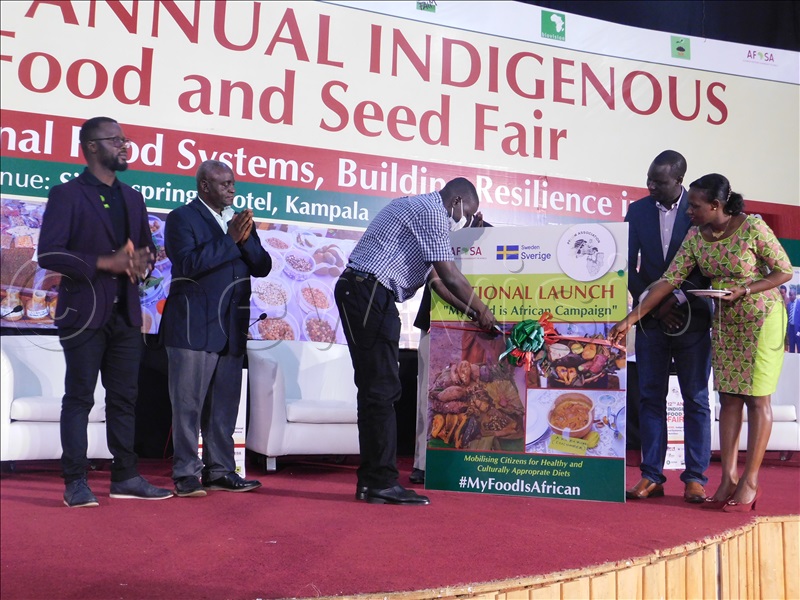Silver Springs Hotel parking yard was rich in indigenous African foods, last Friday, October 28.
This is because the 12th Annual Indigenous Foods and Seeds Festival was on. From common beans, maize to rare climbing foods, birds, even goats, and exhibitors came from all parts of the country.
“I like the mix of not just African, but also organic foods here on the show. You see, when you eat indigenous, you eat healthily,” Edward Mukiibi from Slow Food Uganda, who was one of the exhibitors, said.
Organised by PELUM Uganda, the day celebrates indigenous and organically produced foods, with the main objective of saving them.
“Our wealth is in our land and when we grow indigenous foods organically on this land, we improve our health too,” Andrew Ojok Olanya, MP and member of the Committee on National Economy in the Parliament of Uganda, said.

During the exhibition, a campaign dubbed ‘My Food is African Campaign’ was launched to promote indigenous African foods.
What is organic farming?
Prof. Charles Ssekyewa, the African Continental Chairman for the Ecological Organic Agriculture Initiative who is a trainer and researcher in Organic Agriculture and promoter of Agro-Ecology, said that organic agriculture is a production management system which avoids the use of synthetic and harmful pesticides, fertilizers, growth regulation and livestock feed additives to reach a long-term goal of sustainable production of crops and animals.
“The system relies mainly on alternative farming methods such as crop rotation, mechanical cultivation; use of animal and green manure and integrated pest management to maintain healthy soil; grow healthy plants and control pests and weeds,” he says.
“There is a very big potential for organic farming in Uganda and across the world. However, many Ugandans are not aware of the sector mainly because the foods are sold in the same markets as other foods,” he said.
He pointed out that any future construction of large and small markets should have specific space for certified organic foods.
According to Sunday Bob George, the Senior Agricultural Officer, MAAIF, as of 2019, Uganda had over 210, 352 internationally certified organic farmers, the first and second largest certified farmers in Africa and the world over respectively.
The highest number is found in India. Uganda had the world’s 13th-largest land area under organic agriculture production and the most in Africa.
In 2019, Uganda had around 262,282 hectares of land under organic farming covering more than 2% of agricultural land.
Sunday Bob George pointed out that it is time for Ugandans to grab this opportunity.
“Our potential can put about 500,000 hectares under organic and 500,000 farmers certified internationally.
He further explained that if this is done, the volume of organic produce will increase from the current 115,02MT to 210,000MT.
Member organizations are over 500 in Uganda and outside the country.
The value of trade-less organic turnover is currently over US$50m per annum. The demand for organic products from Uganda is about US$600m.
Products grown organically and sourced from Uganda include Coffee (both Robusta and Arabica) cotton (lint, yarn and finished garments), sesame (simsim), dried fruit (pineapples, apple bananas, mangoes, jack-fruit), fresh fruits (pineapple, apple bananas, passion fruits, avocadoes, papaya (pawpaw), ginger), jack-fruit, vanilla, cocoa, fish, shea butter and shea nuts, bird eyed chilies, dried hibiscus, honey and bark cloth.
Growing organic includes processing your pesticides and manure.
Making compost manure fertilizers?
Various types of vegetative materials and farm waste can be used, such as maize stovers, soybean and bean stovers, finger millet, banana peelings, rice and sorghum straws, sweet potato vines, cassava or potato peelings dry and green grass, animal and poultry wastes or slurry/kitchen wastes etc.
-Dig a pit 45cm deep (square or rectangular in shape). Put the soil on one side. Put 4 poles (2m long) 1 for each corner of the pit. After setting up the pit, then chop the available materials into small pieces and put the first layer.
Pile up to 45cm deep then sprinkle 10 litres of water. Add the second layer of dry vegetation of hedge cuttings to about 20cm thick and sprinkle water then put the third layer of animal or poultry waste or slurry, this provides microorganisms that are essential for decomposition.
-You can then add the fourth layer (about 20cm thick), consisting of green materials from leguminous trees such as Calliandra, Leucaena, Tithonia etc. Sprinkle a little topsoil up to 5 cm thick. The soil contains bacteria, which helps in decomposition.
-Repeat the placement of layers as in the steps above starting with dry vegetation, then animal or poultry wastes/slurry, ash, green vegetation and topsoil. Remember to sprinkle water on every layer. The final pile should be 1.5-2m high at most with vertical sides and a flat top. To complete the pile, cover it with a layer of 10 cm thick topsoil. Finally, cover the whole compost pile with dry vegetation e.g. banana leaves to reduce moisture loss through evaporation.
-Monitoring decomposition: Decomposition starts 3 days after pile formation. Drive a long pointed stick at an angle to check the decomposition. The stick should be left in the pile and only removed once a week. When you pull out the stick from the pile, it should be warm and moist but not wet.
– Sprinkle 20 litres of water on the pile every three days during dry spells. After 2-3 weeks, turn the pile. Compost is ready after 6-9weeks depending on the type of material used. Ready compost should have a fresh soil smell and should not contain grass, leaves or animal or poultry waste.
-Storage: Store compost by covering it with polythene or banana leaves or under a roof. Compost can be stored for 3 – 6 months.





